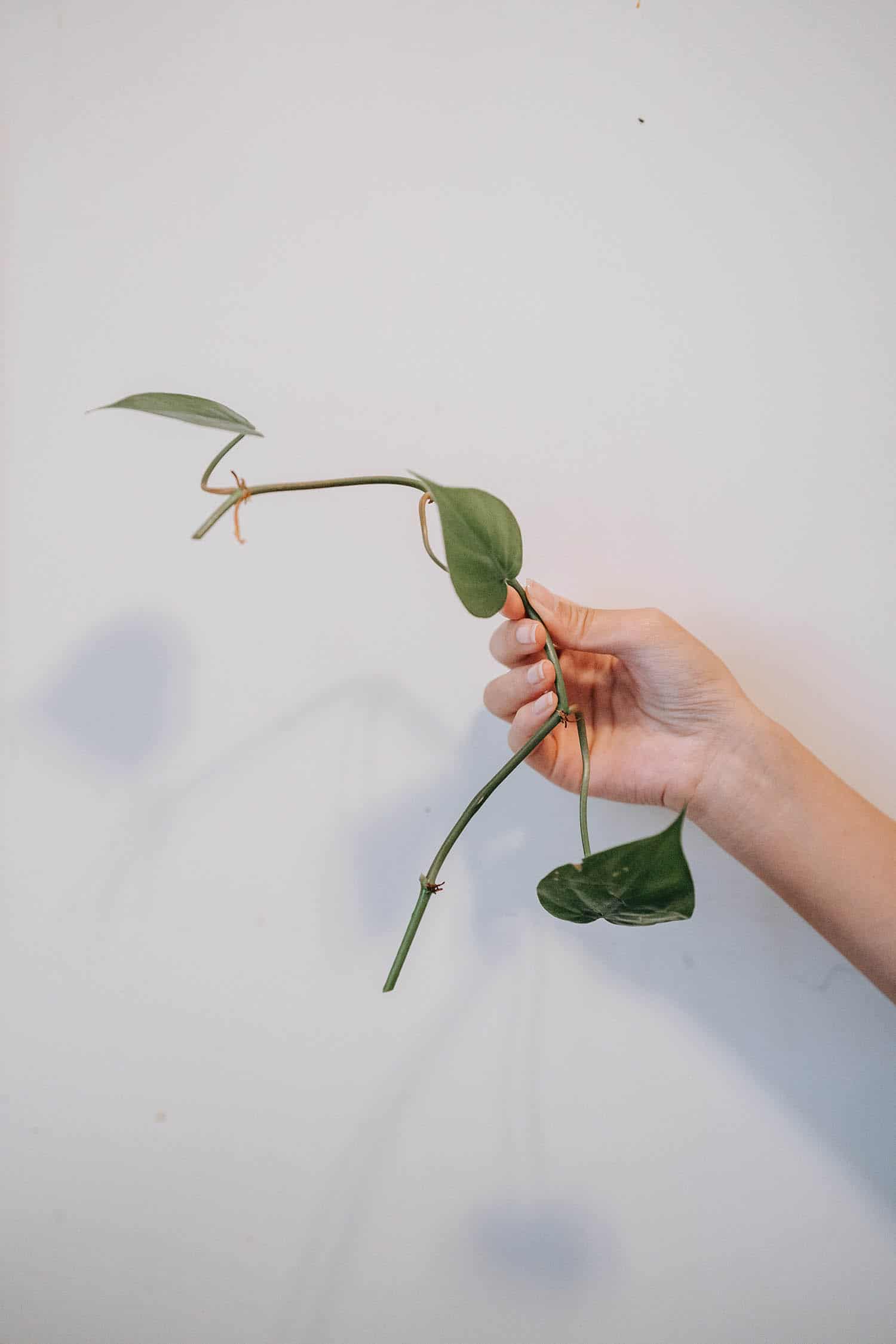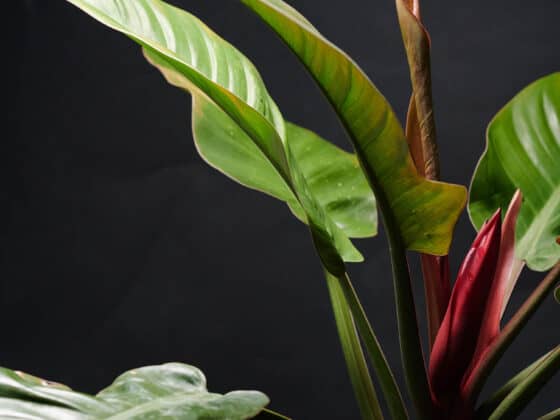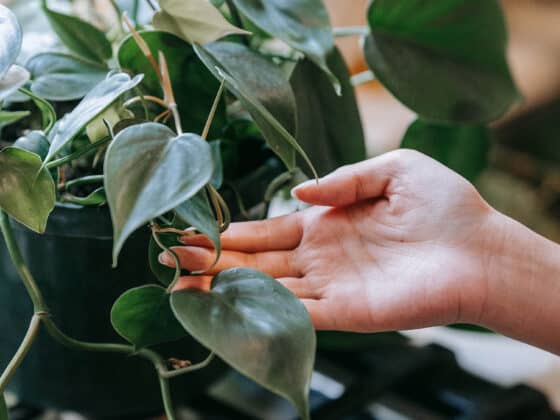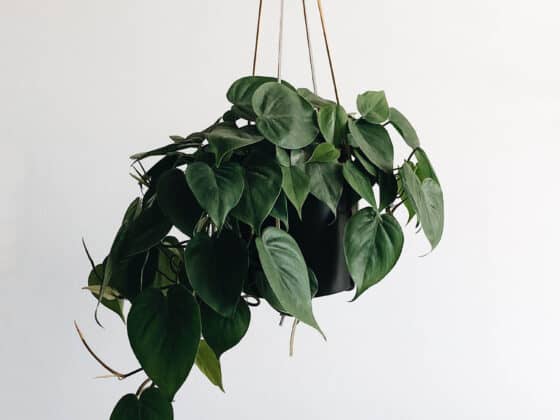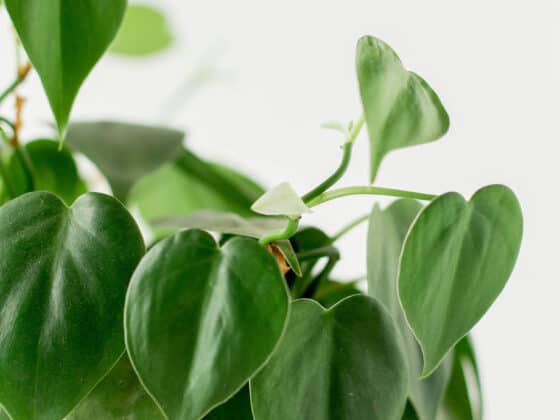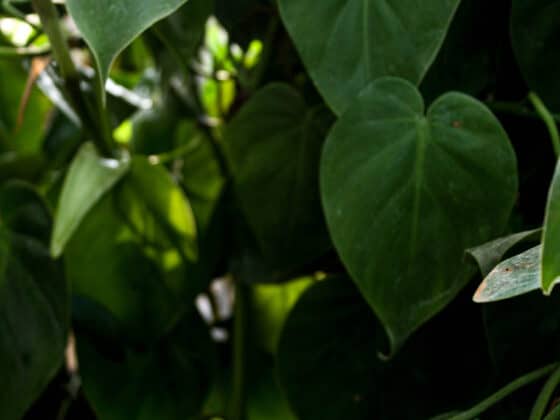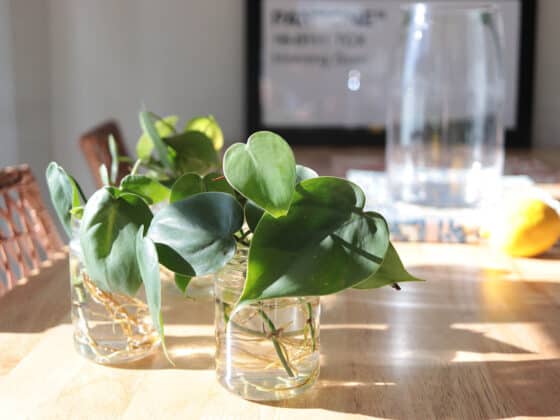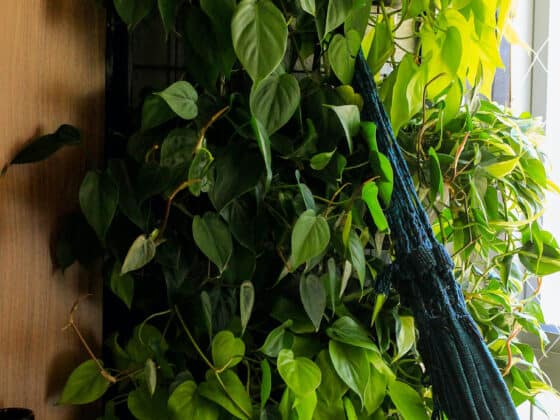One of the best things about Philodendrons as houseplants, aside from being easy to care for and great foliage plants, is that they are also very to propagate. In fact, the vining varieties of the genus actually thrive when regularly pruned, which facilitates lots of opportunities to propagate new rooted cuttings.
What’s the best way to propagate Philodendrons? While there are several different methods that offer varying degrees of success, some variation of a stem cutting, rooted out in either water or soil, tend to be the easiest and most successful means of propagation. Once new cuttings have rooted out, transplanting your new Philodendrons to a larger pot will encourage the plants to establish and grow.
There are several different ways of propagating a houseplant; we’ll cover the most straightforward and successful methods for Philodendrons. Why complicate things if you don’t need to? We’ll go over how to take a proper stem or leaf cutting, different methods of rooting them out, and what the next steps are to end up with new, fully mature Philodendron plants. Let’s dive in!
A Quick Note on Self-Heading (Non-Trailing) Philodendron Varieties
It is worth mentioning early on in this article that most of what we cover applies to the vining varieties of the Philodendron genus. This is because the larger, self-heading (or tree-like) varieties have a physiology that makes at-home propagation not only more difficult but much riskier, especially when you are dealing with a rare variety.
In general, self-heading Philodendrons have very short internodes (the space between nodes), and the leaf petioles tend to fully cover the stem. Because of this, learning how to take a proper cutting from these types of plants is difficult and often unsuccessful. In fact, commercial propagation of these types of Philodendrons doesn’t often happen from cuttings at all. Instead, growers opt for either seed production (in some varieties) or use the advanced science of tissue culture to create new plants from the stock they have on hand. Both of these methods are a bit beyond the casual houseplant enthusiast.
If you are determined to propagate your own self-heading varieties at home, there is a short section below that covers the methods you can try. Although there are a few success stories online (and a few universities’ horticulture extension websites that merely confirm the possibility of success), we tend to recommend against self-heading propagation at home. More on this later.
Can You Grow a New Philodendron from a Cutting?
Yes, you certainly can! Like many other houseplants, as long as you take a proper cutting containing everything the plant needs to generate new growth, it should have no problem rooting out into a new plant. So, what exactly is needed to produce a rooted cutting? Probably less than you think. At the very least, all you need is a small piece of stem with at least one node and leaf.
A node (or leaf node) is a small patch of undifferentiated plant tissue that is generally dormant until the plant releases hormones that activate it. This tends to happen any time we make a cut or break along the stem. The release of hormones by the plant activates the node to start producing new plant material necessary for growth, mainly roots or a new growth tip.
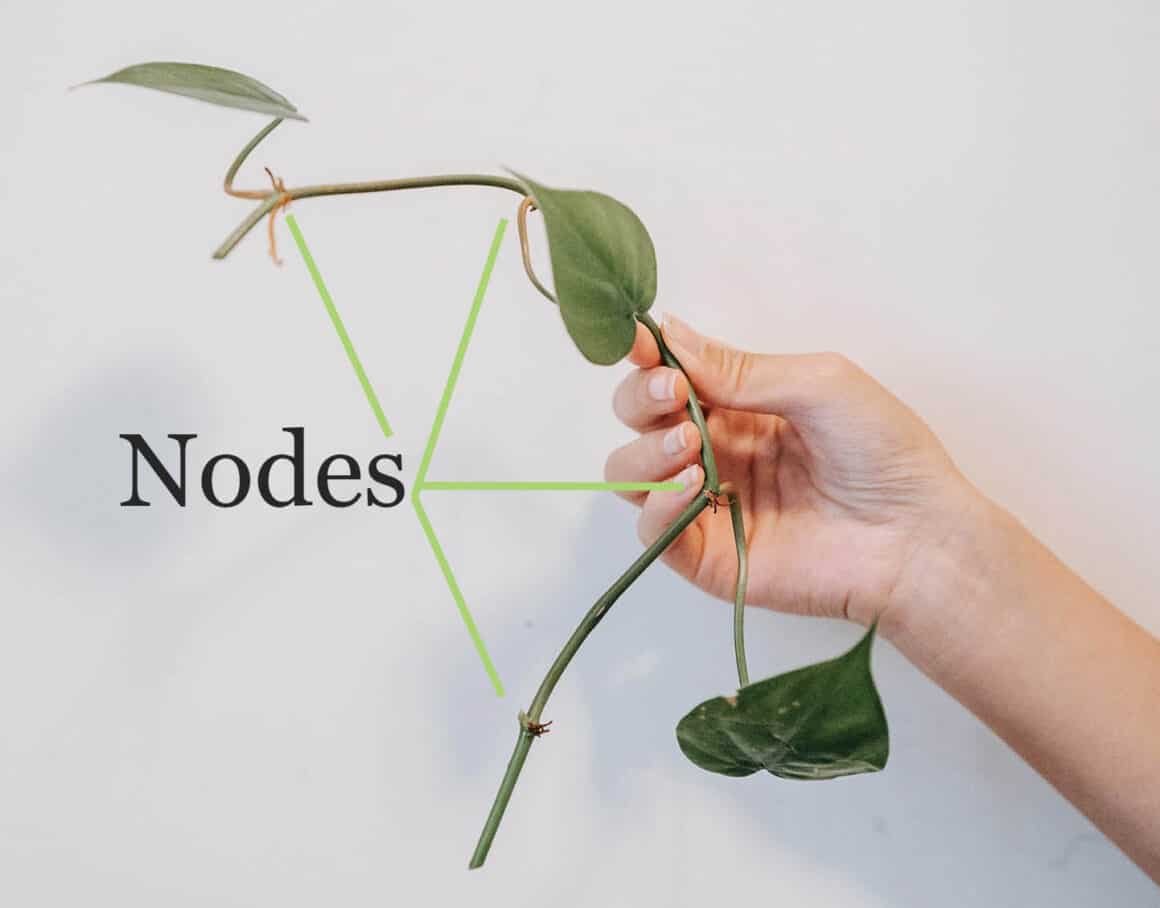
Without a node present, the cutting you take has no way of producing new plant tissue and, therefore, won’t be able to grow into a new mature plant. The node is the key! In fact, a leaf isn’t even totally necessary to create a rooted cutting, although it can certainly help by providing essential functions like photosynthesis and gas exchange.
Regardless of the type of cutting you choose, they will only be successful in rooting out if you manage to preserve an intact node.
Can You Propagate a New Philodendron from a Leaf?
Based on what you just read above, it’s probably no surprise that a single leaf from a Philodendron plant will never grow into a mature plant. In some cases, you may be able to get roots to grow from the leaf in water eventually, but without a node, no new plant tissue can be produced, so your single leaf cutting is doomed to fail.
Preparing to Take Philodendron Cuttings
If you are ready to give propagation a shot, there are a few things to consider before you make any cuts to ensure you are successful.
First, you always want to ensure you take cuttings from a healthy plant. Stressed, wilted, unhealthy, or pest-ridden plants don’t produce great cuttings, so if you notice your plant is going through something, we suggest you deal with that before you propagate. You need to put your plant’s health first.
Generally, you also want to consider the time of year when thinking about taking cuttings. This is especially true if you are trying the trickier cuttings from a self-heading Philodendron. For most larger prunes we make, we tend to wait until springtime when the plant is actively in its growing season and still has ample time to recover and push new growth before the slower winter months.
The warmer, summer months are also better for your cuttings, since heat encourages the cuttings to root out. Depending on how much warmth and light they receive, you will likely see a difference in how fast it takes cuttings to produce new roots and push new growth. You can, of course, trick them by adding heating pads or grow lights into the mix.
The good news is that, for trailing Philodendron varieties, you can pretty much prune whenever you feel like the plant needs it. In fact, regular pruning of these types actually encourages healthier growth from the plant, producing much fuller, well-stacked leaves. There’s no need to worry about where it is in its growth cycle, although you’ll likely need to prune much less during the winter.
Lastly, gather up the tools you’ll need, depending on the type of cuttings you are taking and the method of propagation you are using. Typically, this means you’ll need a clean, sharp pair of gardening shears or scissors. Don’t overlook the “clean” or “sharp” adjectives in that last sentence. You need clean tools to avoid spreading disease, and you want them sharp to minimize the amount of damage you are inflicting on the plant so it can recover faster.
You will also need some glass jars or cups and access to water. If you are rooting your cuttings out in soil, you will want to have small pots and your potting soil handy, as well.
How to Take a Philodendron Cutting
Now that you have all the tools you’ll need and have determined your plant is healthy enough to take cuttings, you are ready to propagate. Depending on your plant, you can opt for a couple of different techniques to prepare your cuttings.
Stem Cuttings
Likely the easiest cutting to take from your Philodendron is a stem cutting. This is when you remove a vine from your plant and only use the growing end of the stem to create a new rooted cutting. The biggest advantage of this method is that the cutting you create will already have leaves and an active growth tip (or meristem) intact and ready to go. All it needs is a new set of roots, and it is well on its way to becoming a new, mature plant.
There are some drawbacks to stem cuttings, however. First, because this type of cutting is created from the end of a Philodendron vine, how many cuttings you end up with is determined by how many vines you are willing to trim off your plant. The other potential downside to this type of cutting is that Philodendron vines tend to start growing a little scraggly the longer they get. This is a natural process for the plant where the internodes on the vine start elongating faster.
However, depending on how old the vine is, you may have a stem cutting with only one or two leaves because they are spaced so far apart. Neither of these are dealbreakers, but it’s good to be aware of these situations when deciding if you want to take stem cuttings.
To properly take a stem cutting, locate the vines that you want to trim back on your Philodendron. At the end of each of these vines, count back three to six leaves and use your garden shears to make a clean cut just below where a leaf branches from the stem.
You should have a piece of stem roughly five to eight inches in length, with at least a few leaves attached. You can clip off the bottom leaf where you made your cut. The node located just above it is what will be submerged in water or soil and encouraged to root out.
Leaf Node Cuttings
Another approach to propagation that creates many more cuttings is called leaf node cuttings or leaf bud cuttings. These are different from stem cuttings in that, rather than preserving a longer section of stem with the growth tip, you actually cut the stem into smaller pieces only a couple of inches in length, making sure to include at least one leaf and one node.
The idea here is to create smaller cuttings that will eventually produce all new growth (roots and a stem) from the solitary node. These obviously take a little longer to produce new plants, but the advantage is that you can create several more plants than if you only propagated stem cuttings.
To take these cuttings, start the same way as above and trim any vines you’d like to prune back on your Philodendron. If you want, you can still take stem cuttings from the ends of each vine but don’t throw away the rest of the plant material.
To create your leaf cuttings, locate the internodes along the remainder of the vines. These are the spaces in between the leaves and nodes of each stem; this is where you will make your cuts. Plan to make a cut about one half to one inch above and below each leaf joint, making sure to avoid damaging the node (which is usually located just above a leaf petiole).
If you find the vine has longer internodes, don’t worry. Make your cuts around the leaves normally and just discard the remaining lengths of internodal tissue. They aren’t necessary.
Rooting Out a Philodendron Cutting
Once you have a set of cuttings, either stem or leaf node, the next step is to root them out. At this point, you have a choice to make. You can either root these cuttings out by sticking them in a small jar of water, or you can stick them directly into the soil. For Philodendrons, both methods work well, so it comes down to personal preference.
In my experience, we prefer rooting these plants out in water. It’s a quick, easy method of propagation, and because I am often pruning back my Philodendrons, we’re more likely to throw cuttings into a jar rather than pulling out pots and soil every time. On the other hand, when done properly, soil propagation can be more successful and saves you the added step of transplanting water-rooted cuttings into a growing medium down the road. Either way works well, though, so feel free to experiment with both.
Water Rooting Philodendron Cuttings
If you’ve decided the water method is for you, all you really need is your cuttings, some small jars, vials, or cups, and clean, cool water.
For stem cuttings, arrange them into a jar with the cut ends inside, trying to keep the ends suspended above the bottom. Fill the jar with water high enough to cover each cut end and a few inches of stem to ensure the lowest leaf node is submerged. This is where new roots will begin to grow. You don’t want any leaves submerged, so you might need to remove the lowest ones from each cutting.
For leaf node cuttings, you can fully submerge the stem portion of the cutting in water, leaving the leaf sticking out in the air. You might need to try a few different containers to get the positioning right, but make sure the node on each cutting is submerged.
Once your stem and leaf node cuttings are arranged and submerged, you can place your jars on a window sill that gets a lot of bright, indirect light. Plan on changing the water weekly to avoid scum or mold. Within several weeks, you should start seeing new roots begin emerging from the submerged nodes. This is exciting, but be patient. You want to wait until these roots grow two to three inches before you even think about transplanting them to soil.
When it is time, however, feel free to plant these newly rooted cuttings into a small container that contains a very airy and well-drained soil mixture. Some specialty seedling mixes achieve this texture well, but you can always make your own by adding cactus mix or perlite to regular potting soil to keep it light.
Moisten the soil lightly and then use a chopstick or something similar to create a hole down the center of each container. Gently push your rooted cutting down into the soil, ensuring the roots are covered, and pat down the soil to secure the cutting.
Over the next few weeks, keep the soil moist and the temperature warm to encourage your newly planted cuttings to fully root out and establish in their new pots. Once they are well-rooted, you should see new growth begin to emerge from the tops of the plants.
In the case of leaf node cuttings, the original stem and new roots will be buried in the soil while the leaf remains sticking out. Over time, you will eventually see a new growth stem emerging from the soil. Leave the leaf intact as long as possible to help the new stem capture sunlight for resources to grow.
Soil Rooting Philodendron Cuttings
If you’d rather forego the water rooting method and propagate in soil, ensure you have your containers and soil mixture handy when you take your cuttings. Again, a light, airy soil mixture is necessary to encourage your cuttings to root out. Similar to above, you’ll want to water the soil so it is moist at the time you stick your cuttings. Use your chopstick to create holes, and then stick your stem cuttings or leaf node cuttings down into the soil to submerge the nodes under the soil line.
Some folks like to use rooting hormones to help boost the likelihood their cuttings will root. If you’d like to use rooting hormone, dip each cut end into the powder, making sure the node is covered before directly sticking them into the soil. The rooting powder mimics natural hormones in the plant (called “auxins”) that encourage root growth.
Once your cuttings have been planted in the soil, you’ll want to keep them warm and moist in order to encourage quick and healthy root production. Aim for temperatures above 70°F by placing in a bright window without direct sunlight or the use of a heating pad or seedling mat.
To keep the humidity high, you can either mist your cuttings two to three times a day or use a cloche, seedling tray with a plastic lid, or enclose each pot with a plastic bag that is almost zipped shut. Occasionally check your cuttings and add water if the soil is dry or the humidity seems low.
After about a month, your cuttings should be showing signs of rooting out, and any covers or bags you are using can be removed. After a few more weeks, you may even see stem growth starting up once again.
Transferring Root Philodendron Cuttings
Regardless of the method you used to root out your cuttings, you’ll want to transplant your fully rooted new plants into a larger container at some point. For vining Philodendrons, you’ll probably want to combine several rooted cuttings to form a new plant with a nice full crown.
When we propagate my Philodendrons, we usually end up with several cuttings potted in nursery trays or two inch pots. We like potting into six inch pots next because they are large enough to group plants into without being so large that we have to use a lot of extra soil. We find that we can usually plant anywhere from three to five rooted cuttings together in this size, which makes for a nice, full-looking plant.
When transplanting rooted cuttings, be sure you are using a high-quality potting soil with good drainage. Your baby plants will need to expand their root systems in their new home, so ensuring the soil is well-aerated will encourage this type of growth. We usually mix in a little cactus soil, as well, just to minimize any compaction.
After you transplant, you can expect a short period of time where the plants need to get established in their new pot, but within a few weeks, new growth should resume.
How to Propagate Self-Heading Philodendrons
As promised, we wanted to include some information about self-heading Philodendrons in the event you want to throw caution to the wind and try to propagate your larger varieties at home. Non-trailing Philodendron varieties tend to have very short internodes that get fully covered by the leaf petioles. Essentially, this means that the nodes of the plant are stacked very close together, and any cuts made to the stem end up damaging them, lowering the likelihood that new tissue will emerge from them.
That being said, it is possible to propagate a self-heading variety. The first (and least invasive) method is to divide the plant when “pups” begin to form. These offshoots are new stems that already have their own root system and grow from the soil. They can be separated from the mother plant and potted individually.
Not every Philodendron will create offshoots and it can take a LONG time for them to be produced. If you are going to go this route, prepare to be patient. When these pups do appear, you may need to remove your Philodendron from its pot and untangle each offshoot from the rest of the plant, working to preserve as much of their root systems as possible. If you lack the patience to wait for pups, you can take the more drastic approach and take a stem cutting.
Find exactly where you want to make your cut by inspecting the stem of your Philodendron closely. Look along the stem and even feel with your fingers to identify the nodes. They will feel like small bumps or ridges along the stem. Make your cut so that the section of stem being removed has at least two, if not more, nodes near the cut base.
You also want to pay close attention to any aerial roots. These types of Philodendrons produce aerial roots for support and nutrient capture, and as it turns out, a stem cutting with at least one aerial root on it has a better chance of survival.
Once you make your cut, place your stem cutting in a glass of water so the nodes near the cut are submerged. Again, plan to change the water once a week for several weeks while new roots grow from the submerged nodes. Eventually, you can transplant your now rooted stem cutting into potting soil.
If all goes well, you’ll have a new plant from your cutting, and the mother plant will hopefully begin growing a new stem from a node just below the cut you made. This can take quite a while, so be patient and monitor the plant for any signs of stress during this time.
Why Doesn’t My Philodendron Cuttings Have Roots?
A very common question regarding Philodendron cuttings is, “Where are the roots? Many people take cuttings and expect to have them fully rooted and transplanted within a matter of weeks, but in reality, this process can take several months, depending on the variety.
First off, you must be patient. If it’s only been a week or two after you’ve taken your cuttings, you need to wait longer. Remember that your cuttings are creating new tissue from scratch, which can take some time. Generally, in proper conditions, a cutting may take four to six weeks (or LONGER) to root out in either soil or water. This seems like a very long time, but as long as the stem of the cutting still looks plump and healthy, good things are happening.
Second, cuttings need heat to develop new roots, so if it’s been several weeks and you have nothing to show for it, take a hard look at where you are keeping your cuttings. If you are rooting in water, a good place to set them for light is on a windowsill, but those areas can also be drafty and cold. You may need to move them away from the window a bit to protect them from fluctuating temperatures. For soil rooting, consider adding a heat lamp or heating pad to keep temperatures a little warmer. Be aware, however, that you might need to monitor soil moisture more often.
You may also want to take a really close look at each cutting. If you made your cuts incorrectly, you may have caused damage to the nodes that are responsible for pushing new root growth. Alternatively, if the stems have started to rot, there’s a chance the node is damaged beyond repair. If you find that any cuttings have damaged nodes, it’s best to remove them from the mix and start over with fresh cuttings.
Final Thoughts
Philodendrons are wonder plants for our indoor spaces, so knowing how to propagate them is nothing short of a superpower. These resilient plants generally take to pruning well, so you will have no shortage of opportunities to propagate from stem or leaf node cuttings.
Self-heading types are a bit riskier to propagate, but if you want to try it, be sure to take your time and really pay attention to how and where you make your cuts. By following the tips outlined above, you should have plenty of new Philodendron transplants filling every corner of your home. Best of luck!






